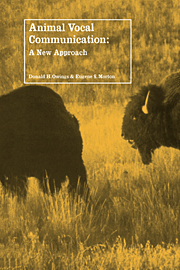Book contents
- Frontmatter
- Contents
- Preface
- Acknowledgments
- Prologue
- 1 Overview of ideas
- 2 The roles of assessment and management in communication
- 3 Form and function in vocal communication
- 4 Mechanisms and proximate processes of vocal communication
- 5 Assessment/management: a viable replacement for the information concept
- Reference
- Index
5 - Assessment/management: a viable replacement for the information concept
Published online by Cambridge University Press: 05 June 2012
- Frontmatter
- Contents
- Preface
- Acknowledgments
- Prologue
- 1 Overview of ideas
- 2 The roles of assessment and management in communication
- 3 Form and function in vocal communication
- 4 Mechanisms and proximate processes of vocal communication
- 5 Assessment/management: a viable replacement for the information concept
- Reference
- Index
Summary
Why the informational perspective is inadequate
Convey versus accomplish
Major problems in the use of ideas and language have occurred in attempts to understand communication. Words often carry additional conceptual baggage that is counterproductive rather than useful. One of the difficulties about using such words is that they are liable to beg the question of causal links between process and product (Bateson, 1990). Concepts should focus attention on the processes relevant to communication. It has been seen that the concept of information is not equal to that task (Chapters 1-4). One reason for this is that it is not easy to ask what is conveyed over a longer time period than that immediately following the acoustic signal. It is, however, possible to ask what is accomplished over much longer periods of time. Indeed, time, long or short, must pass before accomplishment can be described.
The concept of information tends to draw attention to each signal-response couplet, thereby disposing us to treat communication as a chain of such couplets. In contrast, the regulatory process in A/M emphasizes the many time frames in which communicative behavior and its effects are patterned. The ultimate products of communicative behavior consist of evolutionary changes (Chapters 1-3), whereas the most proximate effects consist of the immediate impact of communication on participating individuals (Chapters 2 and 4). For both time scales, effects occur due to the interaction between processes of assessment and management (A/M). A/M describes interactions among communicants in the context of the logic of natural (and sexual) selection.
- Type
- Chapter
- Information
- Animal Vocal CommunicationA New Approach, pp. 228 - 252Publisher: Cambridge University PressPrint publication year: 1998



